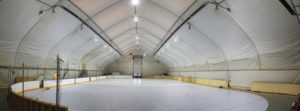We often get asked about when to use commercial synthetic ice verses residential synthetic ice. Probably a good place to start before we get into that is to explore the difference between the two.
The vast majority of panel systems sold today are residential – by our definition. At SmartRink we consider any panel that has little or no vertical sheer strength to be considered a residential panel. The panel thickness is NOT THE DETERMINING FACTOR. Ok so what is vertical sheer strength? There is a test that can be performed on panel connection systems that will indicate the force required to sheer apart two panel joints. So why is this important? This is important when determining the best product for your application. For example if you are considering an outdoor rink in any climate where there are wide temperature variations then you need to consider vertical sheer strength. Panel material WILL expand and contract with temperature changes. For example with a 20 degree Celsius (approx 36 degrees F) a 1 meter (about 39 inches) sheet of Pe will expand or contract about 2 mm (about 0.079 of an inch). This may not sound like much but if it was a 200 foot long rink then that would be almost 5 inches in movement. If the temperature variation was double that then the change is closer to 10 inches of movement! That is a realistic scenario in many North American climates.
Most companies claim to have commercial synthetic ice ice. They don’t. What they call a commercial panel is a thicker panel. So whether their panel is 3/8 inch thick or 3/4 inch thick the vertical sheer strength in most systems still amounts to almost zero.
This really shows up (in a bad way) when these systems attempt to put in goal creases and line markings in the rinks. Most use a “loose laid” colored panel (red line, blue line) and they are not positively connected to the surrounding panel system. It looks nice enough at first – but wait until the inevitable temperature change and voila – instant problem. Now you will see gaps and loose fitting lines where the puck can not even go over these areas. if water gets in there and then freezes – now the lines and panels are coming apart because there is no vertical sheer strength. The darker colored lines expand and contract at different rates verses the lighter colored panel material and this further causes problems.
We have seen this numerous times with competitive products. They are NOT well engineered for what we would consider a heavy duty commercial use system. This includes hockey training centers and larger inside or outside installations.
So in summary here are some scenarios for when you should use commercial synthetic ice:
– outside community synthetic ice rinks – any size
– most definitely in any climate where frost, ice, snow, are anticipated
– any location where there will be a significant change in seasonal or day to day temperature
– Hockey training centers or any application with directional weight shifts
– Any application where the substrate under the synthetic ice not perfect

